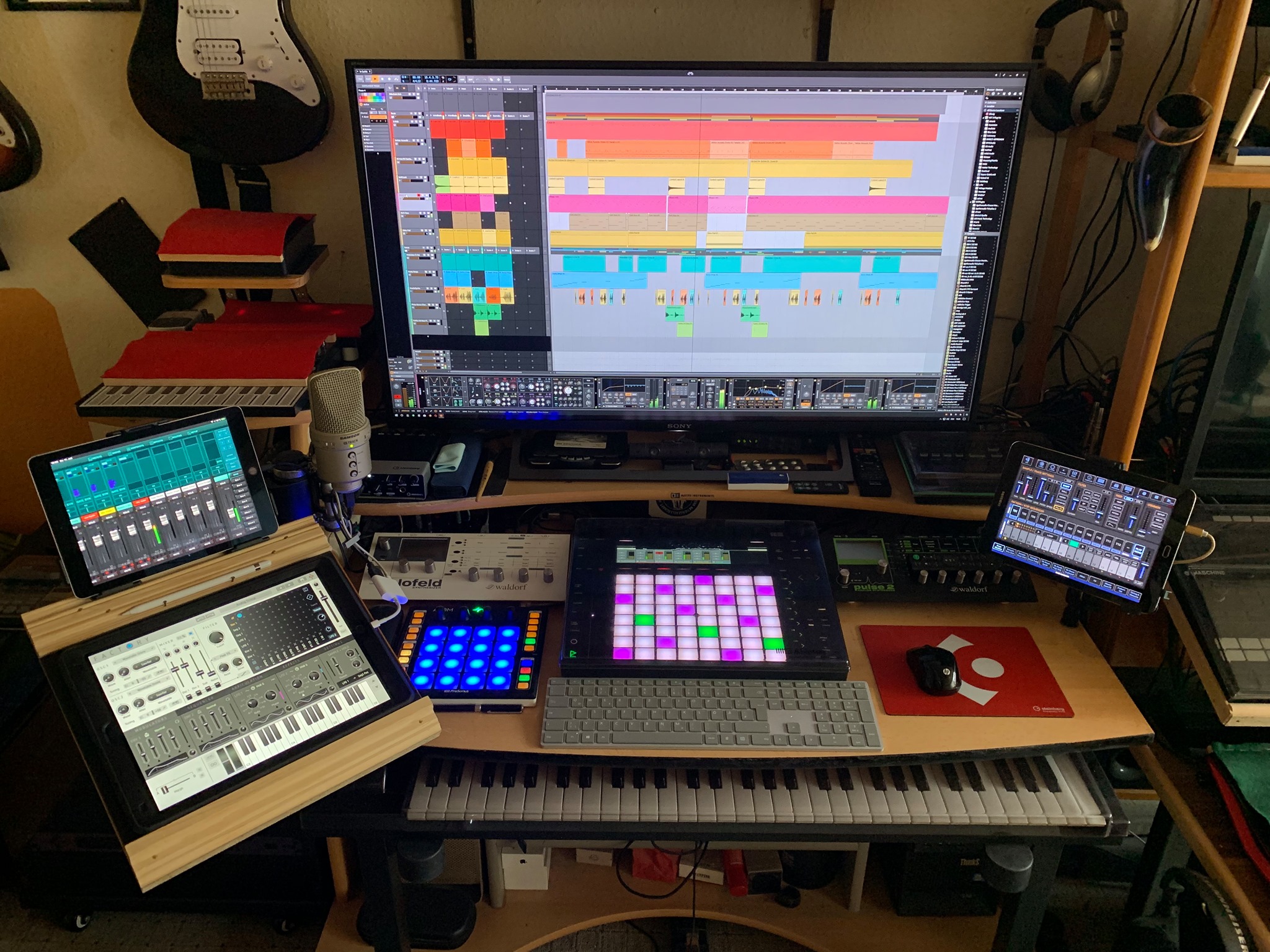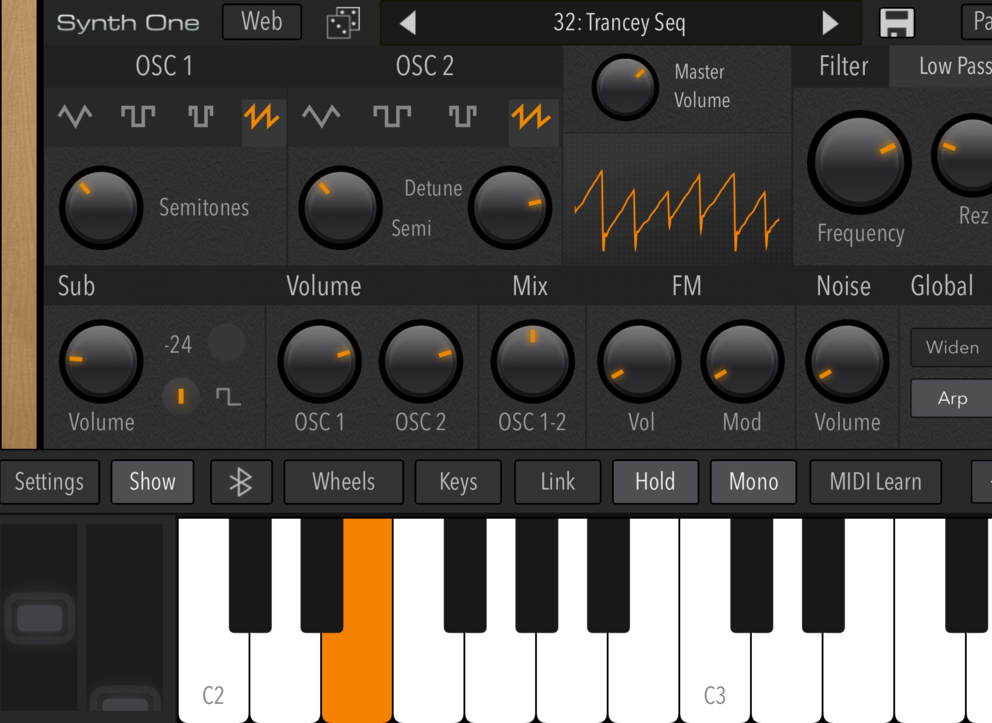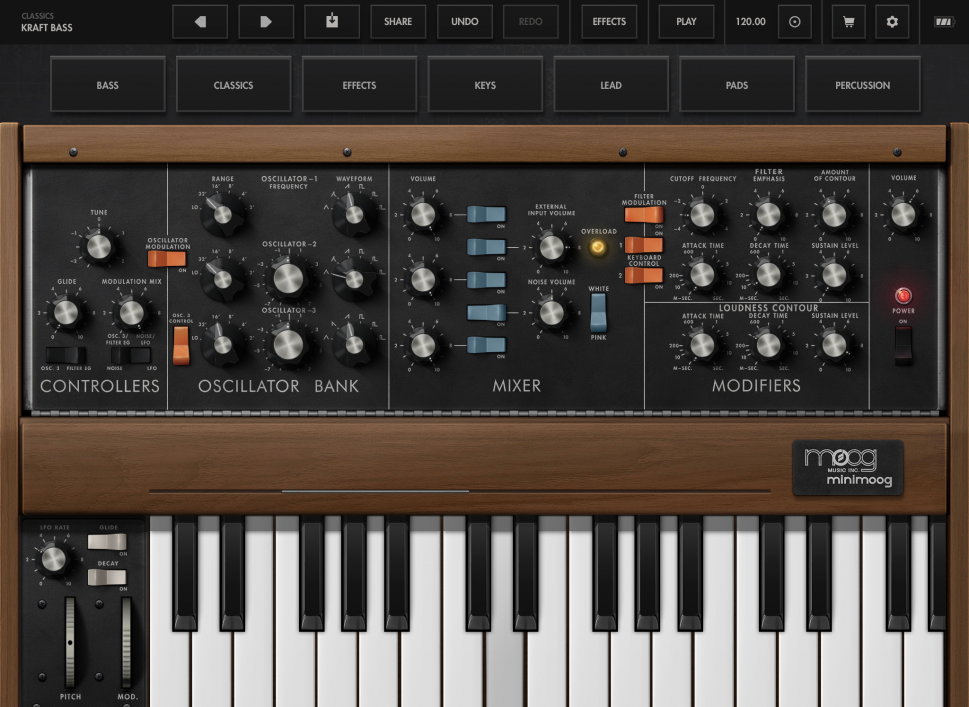Complete studio for under 100 euros - What are synth apps for iOS good for?

Synthesizers - a great invention, but there are so many that can do something particularly well and why you just have to have them. The purchases add up in no time and the bank account suffers. However, there are app alternatives that are both inexpensive and offer many advantages. Synth freak and Beat reader Carsten Herbst reports ...
Ihave three iPads and a Surface Pro 4 permanently installed in my studio. The mounts are screwed to my desk in places that are ergonomically convenient for me, so that the tablets have a fixed place and the cables are out of the way. All of the iPads are equipped with UR22 or UR44 audio interfaces from Steinberg, through which they can charge the battery on the one hand and have a decent audio out on the other. In addition, each iPad has its own MIDI port. By the way, all USB interfaces that are class compliant, i.e. do not require separate drivers, are suitable. Almost all current interfaces meet this requirement.
The audio outputs of the iPads end up in Behringer XR18 mixers, of which I have a total of four cascaded in my studio. The Surface Pro is connected to the studio via a USB/MIDI interface and the audio out also goes into an XR18. So I can address each tablet with 16 MIDI channels each. The power that results from this is gigantic!
Using apps like StudioMux or Audiobus 3, I can directly address 16 apps per tablet, each with its own MIDI channel. channel directly like an external hardware synth. I can also assign AudioUnits as effects to each app. The limits here are only defined by the processing power of the tablets. Apart from the sound generation, there is the advantage that I can put the control software for the XR18 mixer on the tablets. This gives me direct control over 16 channels per tablet. The control app even offers multitouch, so it almost feels like a real mixer. And since the console itself requires almost no processing power, I can run the routing to the synth apps in the background.
If you want to expand your studio and have a tablet, you should buy your synths as an app. It doesn‘t get any cheaper than that.
My app recommendations
Since the apps are ridiculously low in price, I actually have pretty much every synth out there. With an average price of 5 - 20 euros per app, this should be affordable for everyone. The really great thing is that once you buy an app, it can be used in parallel on any iOS device. That‘s like buying not just one Minimoog, but several! Not only do they sound authentic, they are also polyphonic with four voices. Many really good synthesizers even cost nothing on the iPad, such as Synth One from Audiokit. This synth is very fat on its own. One of the most expensive apps, on the other hand, is LayR at 25 euros, but on the one hand it is 16-voice multitimbral and on the other it offers 256-voice polyphony or, in the most extreme case, 256 monophonic layers. This app is one of the best VA synths I know, app or plug-in.

Hardware and �controller for the haptics
Apart from the price and the really good handling of the tablets, the biggest advantage is the offloading of processing power away from the DAW. The Surface in particular is important here, because it can offload the load of the VSTs as well.
But the Surface also makes real sense in other places, like when you use VCV Rack 2 or Voltage Modular. I don‘t even need the VST version of VCV Rack, I just launch it on the Surface Pro and it‘s controllable in my setup. Speaking of controlling it: Together with a Midi Fighter Twister from DJ Techtools as a hardware controller, this is really fun and costs only a fraction of a real modular system.
Which tablet should it be?
To the question of which tablet I would now recommend: Clearly the iPad Pro with 12“ screen. But for studio use, the Surface Pro is also extremely useful, as it can outsource VST plug-ins as mentioned. VArranger, for example, offers a really good automatic accompaniment and is compatible with various style formats. The VArranger just screams for a tablet, because the touch operation makes much more sense than a mouse. If I run Adam Szabo‘s Viper plug-in on the Surface Pro, I effectively have a complete Virus TI2 in the studio, for a price that can‘t be beaten. And the tablets are also much cheaper than most synths on eBay.
Flexibility and mobility
The best feature that convinced me from the beginning is the extreme flexibility, because an iPad is not „just“ another synthesizer in the setup, but a universal hardware tool. The iPad can also be a completely independent DAW if you use Cubasis or Nanostudio 2. And with that, the iPad can also be seen as a standalone workstation on the go, which is clearly more than any standalone groovebox could offer me. The only thing I miss is the haptic feedback of a hardware groovebox, but that can be solved with controllers and a tablet is almost unrivaled for on the go.
6 must-have apps, that should be on every tablet
AudioKit Synth One

Up to 6-voice polyphonic synth with frequency modulation. Five oscillators, LFOs, filters and envelopes are included. More than 300 presets, ranging from typical analog basses to sharp lead sounds and dense pads, ensure direct playing fun. Plus polyphonic arpeggiator, 16-step sequencer and over 100 alternative scales and tunings.
audiokitpro.com | free
KV331 SynthMaster One
Thanks to the wavetable synthesis, results can turn out very diverse - whether vintage sounds or modern dubstep, a lot is possible. A huge effects section, many modulation options, polyphony, arpeggiator and step sequencer as well as the very good sound quality make the instrument a real workhorse.
kv331audio.com | 19,99 Euro
Minimoog Model D & Animoog Z

Two absolute no-brainers from Moog. Besides the classic synthesizer features like ladder filter, three oscillators, fast envelopes etc. Model D also has quadruple polyphony and an arpeggiator. The Animoog Z, on the other hand, is all about modulations, i.e. movement in the sound. Graphically great done, sampling included and free!
moogmusic.com | 14,99 Euro (Model D) free (Animoog Z)
Living Memory LayR
The sound designer‘s favorite: multi-timbral synthesizer with up to 256-fold polyphony. An instrument can consist of up to 128 (!) synths, which can be edited and twisted in detail. In addition, there is a combination of arpeggiator and sequencer, full MIDI compatibility and countless presets. For around 25 euros there is nowhere more.
livingmemorysoftware.com | 25,99 Euro
Steinberg Cubasis

One of the most powerful and stable audio and MIDI sequencers for the iPad. The DAW inspires with a high audio quality, professional features and extensive import and export functions. Thanks to consistent use of the tablet‘s multitouch capabilities, it also impresses with a high level of ease of use. An app that is worth every penny.
steinberg.net | 29,99 Euro
Bryce Hostetler Tonality Music Theory
If you want to write songs or produce music and don‘t want to rely on pure try & error when finding melodies, you can‘t avoid music theory. Even if the subject seems so dry at first sight, Tonality makes it fun and child‘s play, not least because of the excellent feel. Unreser�vedly recommended
tonality-app.com | 5,99 Euro
Want more? Get more!



Subscribe to the digital edition of BEAT Magazine via Plugins-Samples.com and get more gear, in-depth workshops, reviews and 11 GB exclusive plugins and new sounds with every monthly issue!
Subscribe to Beat Magazine for only 4.99€ per month
